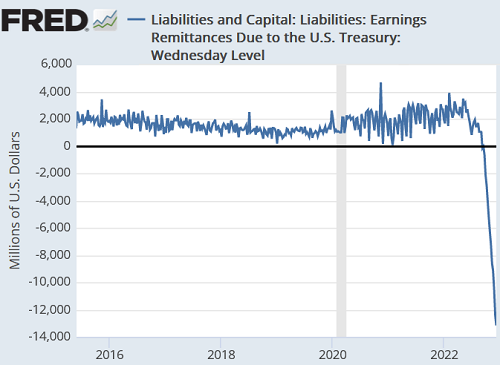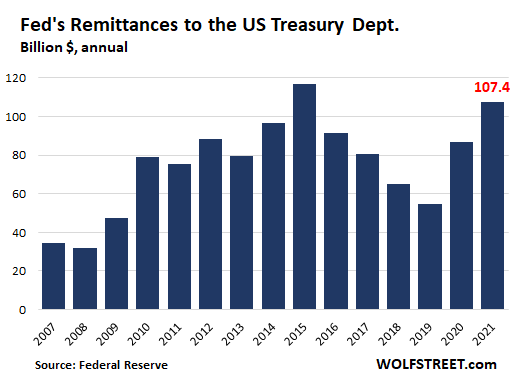by Wolf Richter, Wolf Street:
 We find a good rubbernecking spot.
We find a good rubbernecking spot.
A collapse-chart has been making the rounds in the social media, financial blogs, and the like. It’s being handed around without context, as if self-explanatory, sort of like, look, the world is collapsing. It’s from the St. Louis Fed’s data depository. The title of the chart says, among other things, ominously, “Liabilities: Remittances Due to the U.S. Treasury.” Whatever this is, it’s violating the WOLF STREET dictum, “Nothing Goes to Heck in a Straight Line.”
TRUTH LIVES on at https://sgtreport.tv/
But beyond the funny aspects of the chart, there is something happening on the Fed’s balance sheet that is taking on momentum and heft: How much money the Fed is losing, where this lost money shows up, and how it derails a taxpayer gravy-train. The chart reflects that in a bizarre manner — it does a switcheroo — that we’ll get to in a moment.

A liability is money that the Fed owes some other entity – in this case, money that the Fed owes the US Treasury Department. But this particular liability account, “Earnings remittances due to the U.S. Treasury,” is kind of a funny creature.
It has a negative balance of -$13.2 billion as of the Fed’s weekly balance sheet released yesterday. On a balance sheet measured in trillions, this is pretty small. But it’s going to get a lot funkier.
The Fed’s income, normally.
The Fed’s revenues come from interest and fees. The biggest source is the interest it earns on its $8.17 trillion portfolio of Treasury securities and MBS, which earned the Fed $122.4 billion in interest in 2021. The Fed also charges fees for various services it provides for the banking system. All combined, in 2021, the Fed had $123.1 billion in revenues.
The Fed’s expenses come from operating costs and from the interest it pays. The operating expenses of the 12 regional Federal Reserve Banks amounted to $5.3 billion last year. It also paid interest on reserves and on reverse repos. Last year, with the interest rate it paid on reserves at only 0.15%, the Fed paid $5.3 billion in interest on reserves and it paid $414 million in interest on overnight reverse repos (RRPs). And there were some other expenses. Total expenses amounted to $15.5 billion.
The Fed also paid dividends of $585 million to the shareholders of the 12 regional Federal Reserve Banks. The shareholders of the 12 FRBs are the financial institutions in their districts.
The Fed has to remit its net income to the US Treasury Department. Its net income (revenues minus expenses minus dividends) amounted to $107.8 billion. The Fed has to remit to the US Treasury Department nearly all of its income and any capital in excess of its statutory capital limit, set by Congress. It announces these figures every January, and I dutifully covered it every January, including in January 2022.
Over the past 21 years, the Fed remitted $1.28 trillion to the Treasury Department! Since the start of QE in 2009, it has remitted $1.07 trillion. In this respect, money-printing was a gravy train for the taxpayer.
But this whole thing is going to end because the Fed will have a net loss this year, and for years to come.

How much money can the Fed lose? $280 billion in 2023?
This year, the amount in interest that the Fed pays on reserves (to banks) and that it pays on its overnight RRPs (mostly to Treasury money market funds) has shot up, as the Fed has hiked interest rates from near 0% last year to 3.9% on reserves and 3.8% on overnight RRPs as of early November.
Currently the Fed pays $2.4 billion a week in interest on $3.2 trillion in reserves. And it pays $1.6 billion a week in interest to the counterparties of $2.15 trillion in overnight RRPs. At current rates and balances, that’s a cash outflow of about $4 billion a week ($208 billion annualized).
QT, which destroys money in the financial system, has the effect of shrinking the combined balance of reserves and RRPs. Both of them have come down from their highs, and there are shifts between them. And on a combined basis, both will continue to shrink during QT.
So the balances that the Fed will pay interest on will shrink.
But the interest rates that the Fed pays on those balances will rise by probably 50 basis points next week, and by more next year, and only God knows how far the Fed will go. But each time the Fed raises its rates, it has to pay more in interest.
So if the average combined balances in 2023 of reserves and overnight RRPs is $4.5 trillion, and if the Fed pays an average of 5% on these balances, it will shell out $225 billion in interest.



